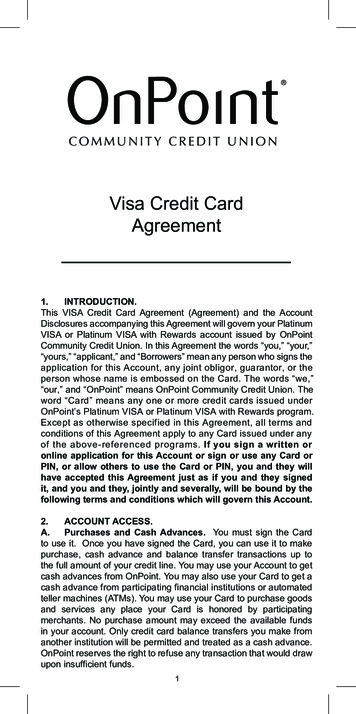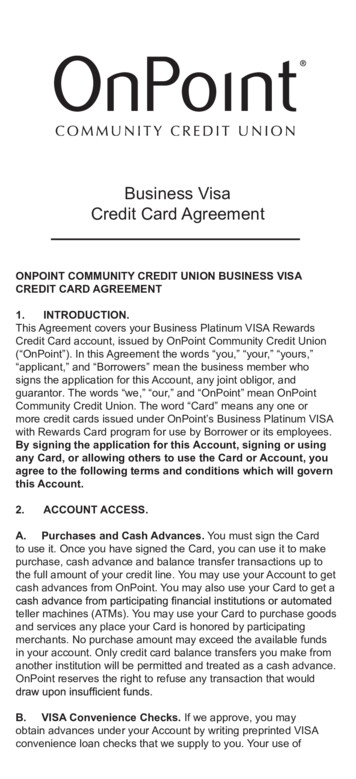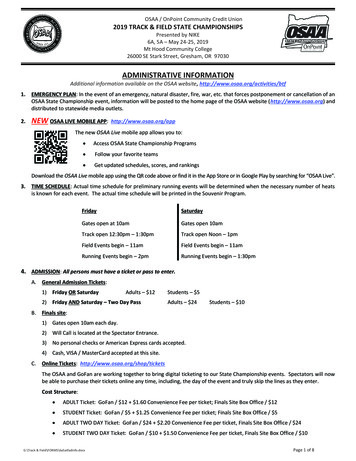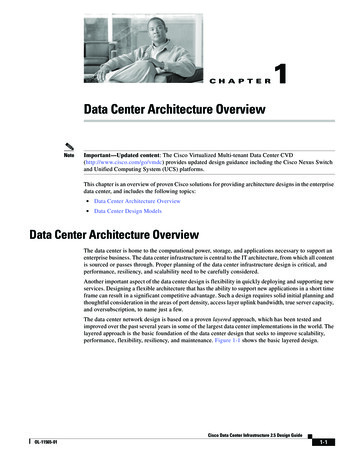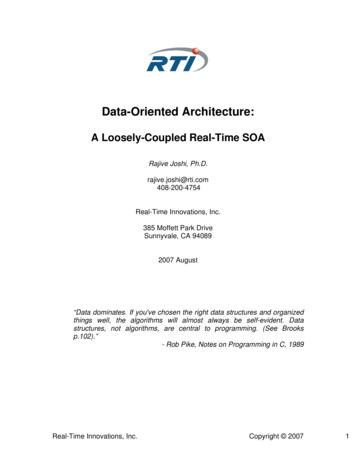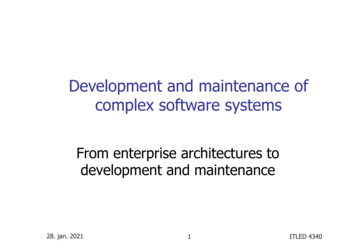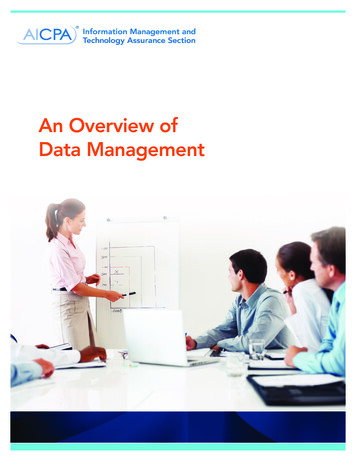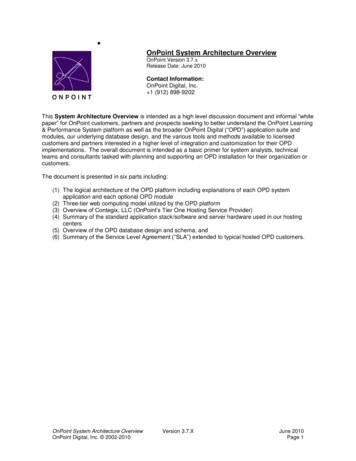
Transcription
OnPoint System Architecture OverviewOnPoint Version 3.7.xRelease Date: June 2010Contact Information:OnPoint Digital, Inc. 1 (912) 898-9202This System Architecture Overview is intended as a high level discussion document and informal ―whitepaper‖ for OnPoint customers, partners and prospects seeking to better understand the OnPoint Learning& Performance System platform as well as the broader OnPoint Digital (―OPD‖) application suite andmodules, our underlying database design, and the various tools and methods available to licensedcustomers and partners interested in a higher level of integration and customization for their OPDimplementations. The overall document is intended as a basic primer for system analysts, technicalteams and consultants tasked with planning and supporting an OPD installation for their organization orcustomers.The document is presented in six parts including:(1) The logical architecture of the OPD platform including explanations of each OPD systemapplication and each optional OPD module(2) Three-tier web computing model utilized by the OPD platform(3) Overview of Contegix, LLC (OnPoint’s Tier One Hosting Service Provider)(4) Summary of the standard application stack/software and server hardware used in our hostingcenters(5) Overview of the OPD database design and schema, and(6) Summary of the Service Level Agreement (―SLA‖) extended to typical hosted OPD customers.OnPoint System Architecture OverviewOnPoint Digital, Inc. 2002-2010Version 3.7.XJune 2010Page 1
1. Logical Architecture for Hosted ImplementationsFor most customers, the OnPoint Application Suite/Platform is a hosted Software-as-a-Service offeringdeployed on dedicated Intel-based servers (running CentOS Linux OS); all servers are owned (notleased) by OnPoint and supported by internal technical support teams. In some cases, the OPD platformhas also been deployed using Sun Sparc or Sun Ultra-based servers/hardware based on specific scalingrequirements. In either case, all OPD implementations utilize a standard 3-tier web computingarchitecture that provides the flexibility and scalability our customers need to support their uniquerequirements.System Design & Programming Environment. The core OnPoint Learning & Performance Suite is builtusing the popular Java application environment and based on core technologies and industry leadingdevelopment tools and platforms including full support for XML, reusable and platform-independentcourseware standards (via SCORM compliance), and AJAX. As a Java-based application, OnPoint’sOPD offering runs on almost any standard web platform. For enterprise customers, OnPoint's solutionscan also be deployed using select industry standard Microsoft technologies like Internet InformationServer (―IIS‖) and SharePoint for additional licensing costs. Most installations (and all hostedinstallations) are supported on Linux servers (using CENTOS v5), though we currently support severalenterprise installations running on Sun Solaris, HP UNIX, Windows 2003 Server and Apple OSX serverplatforms. The database for all OPD installations (and all hosted installations) is MySQL v5x though wehave supported enterprise installations running Microsoft SQL Server on Windows platforms in the past;this arrangement is not our recommended configuration.Figure 1 – OPD Application Architecture (Hosted Implementations)System Diagram. The standard hosted implementation (as depicted in Figure 1 above) shows the typicalutilization of OnPoint’s software applications and optional modules. All hosted server configurationsinclude a mix of web, application and database servers/services (see ―3-Tier Web Computing Model‖section below) plus utilities to support representative customer systems administration interactions.OnPoint System Architecture OverviewOnPoint Digital, Inc. 2002-2010Version 3.7.XJune 2010Page 2
Enterprise installations (e.g., in-house platform installations supported by customer IT departments) arealso available from OnPoint based on specialized needs/requirements.Figure 2 – Part A: OPD Hosting Center ComponentsSection Highlights: Part A - Hosting Center Components. OnPoint’s typical OPD hosted configurationincludes a series of standard application and support features as shown in Figure 2 above including:Hosted Web Servers (standard) – OnPoint’s USA-based hosting center currently has 50 OnPoint-owned Dell and Apple file servers in dedicated racks/caged workspaces. Thehosting center maintains a SAS70-Type 2 certification (a copy of the full audit is available onrequest once a non-disclosure agreement has been executed and filed).Firewall Protection (standard) – All hosted customers can select from standard webaccess/firewall protection or contract with extended services including VPNs or token-basedaccess.OnPoint Portal Applications (standard) – Standard applications and utilities include abranded and/or customized OnPoint Portal, Course Manager (for admins) and PerformanceManager (for supervisors/business managers).Messaging & Notifications Engine (standard) – Standardized support to generate, packageand deliver email and one-way SMS messages based on defined triggers. Optional 2-waySMS messaging support is available for an additional fee.OnPoint Remote Authenticator (optional) – This add-on service module is part of the OnPointAdvanced Portal and facilitates ―Single Sign-on‖ integration with existing Active Directory orLDAP services.OnPoint Ecommerce Tools (optional) – This add-on application module allows customers todefine, offer and manage ecommerce transactions to sell their courseware, classes andother items by credit card over the Internet. Requires separate purchase of a merchantaccount.OnPoint Analytics (optional) – This customized application module allows customers tordpopulate/manage an external data warehouse marrying any OPD data with any other 3party information sources to facilitate deeper reporting and analysis. All data warehousemodules are custom, one-off development efforts.OnPoint System Architecture OverviewOnPoint Digital, Inc. 2002-2010Version 3.7.XJune 2010Page 3
Streaming Media (optional) – This customized add-on module allows customers dealing withlarge video and audio projects to stream their content using an optional streaming serverappliance.Figure 3 – Part B: OPD Customer Premises ComponentsSection Highlights: Part B - Customer Premises Components. Typical OPD hosted installations include aseries of standard application and support features as shown in Figure 3 above including:OnPoint Course Manager (standard) – This is a core OPD application and is used to designcourses, create content and assessments, and deliver the content via the internet. OPCMmanages an organization’s users, plus all content uploaded to, or created within, the system.OPCM’s core functionality includes sophisticated testing/assessment features, online coursecatalogs, ILT calendars with auto-enrollment features, skills tracking/competency management,email/group management, and detailed reporting capabilities. OPCM serves as the foundationfor managing all of the configurations, assignments, security features and interfacecustomizations used across OPD.OnPoint OP-Portal (standard) – OnPoint’s user interface begins with a fully customizable andbranded interface used for presenting on-demand courseware, online assessments andILT/webinar events to an organization’s employees, partners or extended user community. OPPortal provides a structure to extend interface customization and organizational branding througha centralized, unified user interface. OnPoint’s Advanced Portal option includes more robustdocument sharing and contact management and facilitates tighter integration with 3rd partyplatforms and applications, supporting popular directory services like LDAP and Active Directory.Additional utilities include Local/Remote Authenticators that facilitate Single Sign-On (―SSO‖)functionality and seamless access to all portal-launched/managed applications. Optional supportfor federated SSO using SAML assertion methods is also available for an additional integrationcharge.OnPoint Performance Manager (standard) – OPPM provides a secure interface to allow anorganization’s departmental managers, partners and even customers to review the performancelevels and achievements of their associated employees and communities. With OPPM,managers can review course completion and assessment status for all their assignees, generateand view reports, and even fill out evaluations on their team—all through a group-brandedinterface.OnPoint System Architecture OverviewOnPoint Digital, Inc. 2002-2010Version 3.7.XJune 2010Page 4
OnPoint Local Authenticator (optional) – This optional application/utility synchronizes user andsecurity information from a customer’s local Active Directory or LDAP directory service with theOPD platform.OnPoint Integration Services (optional) – This optional application/service is used to integraterdthe OPD platform with existing 3 party applications and platforms generally using the OPDApplication Program Interface (―API‖) or standard web services (―WSDL‖) connectors. Allintegration services are considered customized, value-add offerings.Figure 4 – Part C: OPD User/Learner & Manager ComponentsSection Highlights: Part C – User/Learner and Manager Application Components. All OPDimplementations leverage a series of standard application and support features as shown in Figure 4above including:OnPoint OP-Portal (Portal) or Web Manager (OPWM) Access (standard) – Typically, accessby Users/Learners is facilitated via a customized and branded version of the OP-Portalapplication (for online learners) or OnPoint Web Manager (for CellCast only learners) from anybrowser-enabled, Internet-connected computer. Portal and OPWM interfaces can be customizedto meet the unique application and informational requirements of any defined group, location orsystem role defined in OPD.OnPoint Performance Manager (standard) – For managers and supervisors, OP-Portal andOPWM both provide secure access to the OnPoint Performance Manager (OPPM) application torun reports and perform ongoing training analysis. OnPoint CellCast Solution – OnPoint’s CellCast Solution is an award-winning nextgeneration content delivery platform for mobile learners. CellCast leverages many of samelearning content and communications features currently delivered to desktop users and extendsthese features with several other mobile-specific methods for both content consumption as wellas content creation on basic feature phones as well as advanced smartphones.Interface Customization Considerations. OnPoint’s standard user interfaces and system navigationfeatures are the end result of many years of iterative design, user feedback and enhancements. Ouroverarching design goal is always ―maximum flexibility with intuitive simplicity.‖ In most cases, we offercustomers a variety of methods to accomplish the same actions and navigation requirements and alsomake the interfaces configurable so customers can select what fits best in their environment.OnPoint believes the ―look and feel‖ aspects of the application interfaces should reflect the waycustomers want to work and should fit nicely into the context of all other applications they may havealready. All learner-facing ―learning interfaces‖ can be easily defined and customized based on assignedOnPoint System Architecture OverviewOnPoint Digital, Inc. 2002-2010Version 3.7.XJune 2010Page 5
roles and group associations at the Portal level and made visually compatible with the customer’s owninternal sites and applications. In addition, all learning interfaces are dynamically generated by thesystem to display the specific features/functions, options and ―look & feel‖ that reflect each user’s profileand configuration in the OnPoint LMS database. Different groups (both internal and external) can alsohave their own branding and screen layouts as defined by an administrator. Finally, learner-facinginterfaces are available in multiple languages.Setup-oriented Customization. Our design and development teams work closely with our customers tonot only create the basic ―look & feel‖ elements of the training experience and portal interface but also todevelop deeper integrations and even new application modules that change the system’s power andfunctionality to better meet the customer’s unique requirements. Within the software itself, at the mostbasic level, an administrator can add up to ten (10) unique fields to key tables of the database (Users,Groups, Events, Courses, Skills, Locations, Activities, etc.). [Note that Events and Activities are notincluded functions in a CellCast-only implementation.] These customized fields can be included in anyreporting.OnPoint CellCast Technology (CellCast Solution) – CellCast is a next generation content deliverymodule used to communicate the wide array of digital content and assessments to users via their everpresent mobile telephones and smartphones. OnPoint’s Basic CellCast offering – available on virtuallyANY mobile phone – exists as a combination of technologies best described as standard podcastingcapabilities integrated with IVR-based assessments that are easily accessible by any user/learner withany cellular phone (or via landline). Our Advanced CellCast offering adds support for more engagingmobile media types including animated/narrated PowerPoints, Text/HTML content and PDFs, mobilecourseware/modules and a wide variety of video and Flash-based media content playable across thewidest array of smartphone devices and netbook computers using OnPoint’s internally developedwidgets. All mobile actions/activities are fully tracked and managed via OnPoint’s core applications.CellCast modules include:OnPoint SMS Gateway (SMS Gateway) – For customers looking to deliver message-basedcontent to their mobile workers, OnPoint’s SMS Gateway module allows administrators to defineand deploy interactive messaging campaigns to users via one-way and two-way SMSinteractions. Campaigns can include testing, field surveys, polls, mobile marketing/events andother interactive message series.OnPoint CellCast Manager Portal (OPWM) – OnPoint’s Web 2.0 user interface begins with abranded and customizable interface that provides all users and managers with web access fromtheir desktop PC to on-demand content stored as learning ―nuggets‖ (small pieces of easilysearchable content that facilitate just-in-time learning) and also includes online assessments andother social networking features. For advanced installations, additional portal utilities can beincluded such as Local/Remote Authenticators that facilitate single sign-on functionality andseamless access to other portal-launched/managed applications.OnPoint CellCast Widget Technology – OnPoint’s CellCast Solution includes installableplayers (―widgets‖) designed for every mobile device type, facilitating the download, playback andtracking of content. Widgets are currently available for the following device platforms: Apple iPhone and iPod touch , BlackBerry Wireless Handhelds , Windows Mobile , Google Android,Nokia Symbian and Microsoft Windows-based Netbook ultra-portables.OnPoint CellCast Mobile Web Module – The CellCast Solution also supports the creation,publication and deployment of mobile-friendly, non-media based content and tests to virtually anydata-enabled mobile device via a mobile web browser. While this approach is limited to text andgraphics, installed CellCast Widgets are not required for this form of mobile learning content.OnPoint System Architecture OverviewOnPoint Digital, Inc. 2002-2010Version 3.7.XJune 2010Page 6
CellCast Widget Customization. In addition to online interface customizations, OnPoint’s Technical andSupport Teams work with CellCast customers to address specific customer requirements for content andcommunications delivery to mobile devices. OnPoint’s device applications (―CellCast Widgets‖) can becustomized (for an additional fee for each device requiring customization) to include just thosecomponents of the application that are desired. Other considerations may include system and userpreferences, display icons, auto-installation routines, etc.All customizations are performed with long-term support in mind and they are all designed and developedas logical extensions to our core applications using separate database tables and servlets whereverneeded, but utilizing the same core OnPoint API and Commons Library. These actions ensure that anycustomer–specific settings remain intact and unaffected from normal software update and maintenancereleases.Support for Learning Industry Standards. OnPoint’s market strategy recognizes that conformancewith current industry standards is of critical importance to some customers. Our design and developmentteams continually work with the developer community to ensure support for our core applications withstandards such as the Shareable Content Object Reference Model (SCORM). OnPoint’s CourseManager application does not support AICC content at this time as this is viewed as a declining contentauthoring and delivery standard. However, most of the specification requirements of SCORM v1.2 andSCORM 2004/v1.3 provide support for the majority of AICC specifications. Support for the delivery andtracking of SCORM content on mobile devices is available in CellCast Widgets starting with version 3.x(released summer 2010).OnPoint System Architecture OverviewOnPoint Digital, Inc. 2002-2010Version 3.7.XJune 2010Page 7
2. Three-Tier Web Computing ArchitectureLike most other commercial grade web applications, OnPoint’s OPD application suite utilizes a 3-tierclient-server web computing model. This type of design is identified by its distinct tiers, or layers, thatseparate data storage, business logic processing and client-user interface. These layers are commonlyreferred to as the following:Presentation Tier – This layer is considered the typical User/Learner-facing interface where allinformation/requests from the OPD application are presented to and received fromUsers/Learners. In the OPD environment, these requests are facilitated through the use of JavaServer Pages (JSPs) on the client’s standards compliant web browser. For smaller OPDinstallations, the Presentation tier can coexist along with the Logic and Data Tiers on a singleserver. In larger OPD environments, the Presentation layer can be deployed as separate andredundant processes running across a collection or array of web servers. OPD supports a fewdifferent web server platforms including Tomcat (our standard implementation), Apache andWindows Internet Information Server (―IIS‖).Logic (Application) Tier – This layer encompasses the business logic used by OPD running onour standard Application Server (Tomcat). All information/requests submitted by OPDUsers/Learners from the presentation layer are received here and processed (including actions toread/write information to the database located at the data layer) to facilitate the appropriateresponse by the system back to the User/Learner. This layer is also known as the middle-tier asit sits between, and communicates with, both the presentation layer as well as the data layer. Inlarger OPD environments, the Logic/Application layer can be separated off from the Presentationlayer onto a separate server platform(s) or via newer server virtualization platforms like VMware.Data Tier – This layer houses the applications data storage utilities (using MySQL in the case ofOPD). Depending upon the size and scale of the OPD installation, the Data Tier may either beco-located/housed on the same server as the Presentation and Logic Tiers or separated off ontoa dedicated file server to increase overall throughput and system performance.OnPoint System Architecture OverviewOnPoint Digital, Inc. 2002-2010Version 3.7.XJune 2010Page 8
Figure 5 – 3-Tier Web Computing ModelOnPoint System Architectur
OnPoint Ecommerce Tools (optional) – This add-on application module allows customers to define, offer and manage ecommerce transactions to sell their courseware, classes and other items by credit card over the In
